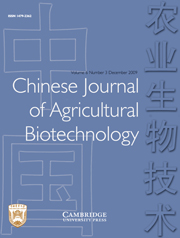No CrossRef data available.
Article contents
Mapping, tissue distribution and polymorphism of porcine genes encoding retinol binding proteins (RBP1 and RBP4)
Published online by Cambridge University Press: 27 June 2008
Abstract
Using the INRA – University of Minnesota porcine 7000 Rad Radiation Hybrid panel (IMpRH) containing 118 clones, porcine cellular retinol binding protein gene 1 (RBP1) and plasma retinol binding protein gene 4 (RBP4) were assigned to porcine chromosomes 13 and 14, respectively. The mRNA distributions of the two genes in adult Wuzhishan pig tissues (lung, skeletal muscle, spleen, heart, stomach, large intestine, lymph node, small intestine, liver, brain, kidney and fat) were examined. One single nucleotide polymorphism (SNP) was identified in Laiwu, Wuzhishan, Guizhou, Bama pig breeds and a Tongcheng experimental population and analysed using a polymerase chain reaction–restriction fragment length polymorphism (PCR–RFLP) method. Significant associations were found between different genotypes of A/G156 and maximum carcass length (LM), minimum carcass length (LN), haemoglobin (HGB), mean corpuscular volume haemoglobin (MCH), and day to slaughter weight (age) traits in the Tongcheng experimental population. This SNP locus might be used as a genetic marker in pig breeding and production.
Information
- Type
- Research Papers
- Information
- Copyright
- Copyright © China Agricultural University 2008
Footnotes
First published in Journal of Agricultural Biotechnology 2007, 15(5): 729–734

